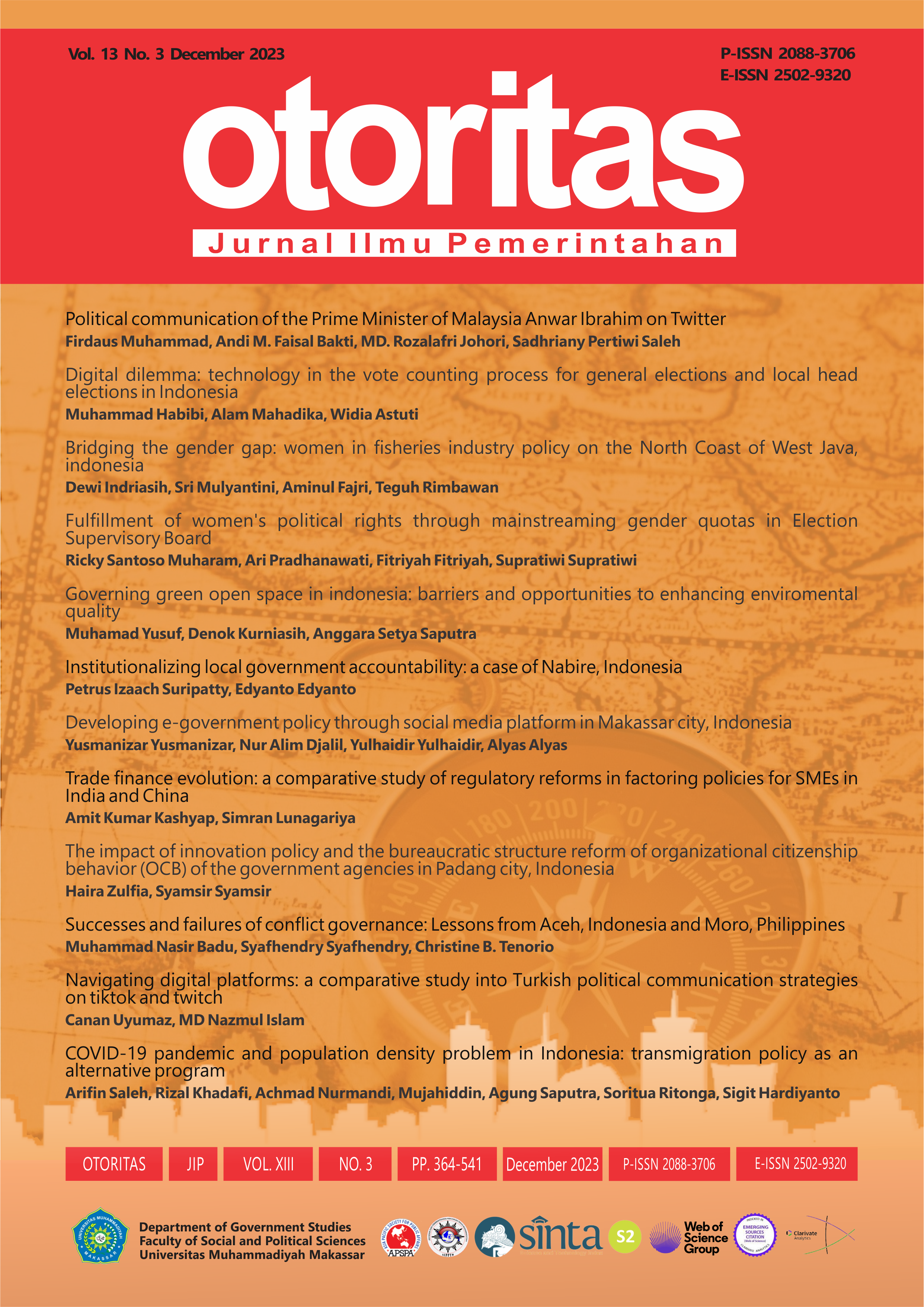Governing green open space in indonesia: barriers and opportunities to enhancing enviromental quality
DOI:
https://doi.org/10.26618/ojip.v13i3.11685Keywords:
Green open space, Public space management, Urban Green Space, Sustainable developmentAbstract
This article discusses the enhancing of governing green open space in Indonesia. It began by looking at the current condition of green open space in Indonesia, highlighting the barriers faced in governing these areas, looking at opportunities to enhancing, and making recommendations to improve green open space governance. Literature review on governance frameworks that can maximize the potential of green open spaces in Indonesia. The results of this study show that there are several constraints in governing green open spaces, including less awareness and understanding among stakeholders, limited funding and resources, inadequate urban planning, limited community involvement, limited law enforcement and monitoring, urbanization and land scarcity, and weak coordination among government agencies in their management bodies. Our findings point to opportunities in governing greenspace areas, by learning from successful projects, exploring global good practices; innovative financing and partnerships; integrating greenspace into urban planning for cohesive neighborhoods; engaging communities for long-term success and shared responsibility; raising awareness of the value of greenspace through educational campaigns; and utilizing technology for data-driven decision-making and community participation. These opportunities contribute to policy recommendations that can be used by the central government and local governments to improve green open space governance in Indonesia.
References
Achmad, A., Hasyim, S., Dahlan, B., & Aulia, D. N. (2015). Modeling of urban growth in tsunami-prone city using logistic regression: Analysis of Banda Aceh, Indonesia. Applied Geography, 62, 237–246. https://doi.org/10.1016/j.apgeog.2015.05.001
Adiyanta, F. C. S. (2018). Partisipasi Masyarakat Sebagai Basis Kebijakan Penataan Ruang Publik dan Ruang Terbuka Hijau Kota yang Berkelanjutan. Adminitrative Law & Governance Journal, 1.
Afriyani, M. P., Iskandar, W., Ridha, S., & Muttakin, M. (2023). Green Open Space Analysis with Utilization Remote Sensing and Geographical Information System in Banda Aceh City. Media Komunikasi Geografi, 24(1), 55–63.
Afriyanie, D., Julian, M. M., Riqqi, A., Akbar, R., Suroso, D. S. A., & Kustiwan, I. (2020). Re-framing urban green spaces planning for flood protection through socio-ecological resilience in Bandung City, Indonesia. Cities, 101, 102710. https://doi.org/10.1016/j.cities.2020.102710
Ajrina, H., & Kustiwan, I. (2019). From green open space to green infrastructure: The potential of green open space optimization towards sustainable cities in Bekasi City & Regency, Indonesia. IOP Conference Series: Earth and Environmental Science, 399(1), 012130. https://doi.org/10.1088/1755-1315/399/1/012130
Ali, S., Sulistiowati, R., Wulandari, C., & Riniarti, M. (2021). Maximizing the social-economy impacts of urban green space in several cities in Indonesia. IOP Conference Series: Earth and Environmental Science, 918(1), 012007. https://doi.org/10.1088/1755-1315/918/1/012007
Ardiansah, A., & Fahmi, S. (2018). The Implementation of the Law on Spatial Planning in Pekanbaru, Indonesia. IOP Conference Series: Earth and Environmental Science, 175, 012079. https://doi.org/10.1088/1755-1315/175/1/012079
Arifiah, S. R. (2022). Implementasi Kebijakan Penataan Ruang Terbuka Hijau Sebagai Upaya Mewujudkan Tata Kelola Kawasan Kota Berbasis Lingkungan (Eco City) Yang Berkelanjutan. Administrative Law, 5(3).
Ariyaningsih, Sukhwani, V., & Shaw, R. (2023). Vulnerability assessment of Balikpapan (Indonesia) for climate change-induced urban flooding. International Journal of Disaster Resilience in the Built Environment, 14(3), 387–401. https://doi.org/10.1108/IJDRBE-08-2021-0111
Belčáková, I., Slámová, M., & Demovičová, Z. (2022). Importance of Urban Green Areas in the Context of Current and Future Global Changes: Lessons Learned from a Case Study in Bratislava (Slovakia). Sustainability, 14(22), 14740.
Bengston, D. N., Fletcher, J. O., & Nelson, K. C. (2004). Public policies for managing urban growth and protecting open space: policy instruments and lessons learned in the United States. Landscape and urban planning, 69(2-3), 271-286.
Bille, R. A., Jensen, K. E., & Buitenwerf, R. (2023). Global patterns in urban green space are strongly linked to human development and population density. Urban Forestry & Urban Greening, 127980.
City Stats. (2022). City Stats | ruang terbuka hijau. City Stats. https://jpi.or.id/city-stats-ruang-terbuka-hijau/
Dahlan, M. Z., Faisal, B., Chaeriyah, S., Hutriani, I. W., & Amelia, M. (2022). The challenges of implementing green factors in urban greening schemes in Indonesia. IOP Conference Series: Earth and Environmental Science, 1065(1), 012015. https://doi.org/10.1088/1755-1315/1065/1/012015
Dupont, L., Morel, L., & Guidat, C. (2015). Innovative public-private partnership to support Smart City: The case of “Chaire REVES.” Journal of Strategy and Management, 8(3), 245–265. https://doi.org/10.1108/JSMA-03-2015-0027
Edwards, N., Hooper, P., Trapp, G. S., Bull, F., Boruff, B., & Giles-Corti, B. (2013). Development of a public open space desktop auditing tool (POSDAT): A remote sensing approach. Applied Geography, 38, 22–30.
Hafiz, M., Budiati, A., & Yulianti, R. (2022). Implementasi Kebijakan Rencana Tata Ruang Wilayah (RTRW) Dalam Mewujudkan Ruang Terbuka Hijau (RTH) Publik di Kota Tangerang Selatan. JURNAL DESENTRALISASI DAN KEBIJAKAN PUBLIK (JDKP) E-ISSN : 2722-5259, 03(02).
Hanafi, I., & Fitrianto, A. (2022). Skenario Kebijakan Tentang Ruang Terbuka Hijau di Kota Batu: Suatu Pendekatan Simulasi. Kolaborasi : Jurnal Administrasi Publik, 8.
Hanan, H. M., & Ariastita, P. G. (2021). Penilaian Efektivitas Fungsi Taman Kota Sebagai Ruang Terbuka Hijau Publik di Kota Malang. Jurnal Teknik ITS, 9(2), D47–D52.
Hansen, R., Olafsson, A. S., Van Der Jagt, A. P., Rall, E., & Pauleit, S. (2019). Planning multifunctional green infrastructure for compact cities: What is the state of practice? Ecological Indicators, 96, 99–110.
Hansen, R., & Pauleit, S. (2014). From multifunctionality to multiple ecosystem services? A conceptual framework for multifunctionality in green infrastructure planning for urban areas. Ambio, 43, 516–529.
Henderson, J. C. (2013). Urban parks and green spaces in Singapore. Managing Leisure, 18(3), 213-225.
Hidayah, R., Sativa, S., & Sumarjo, H. (2021). Strategi Pemenuhan Ruang Terbuka Hijau Publik di Kota Yogyakarta. Inersia: Jurnal Teknik Sipil dan Arsitektur, 17(1), 11-18.
Kim, J.-E. (2012). Green network analysis in coastal cities using least-cost path analysis: A study of Jakarta, Indonesia. Journal of Ecology and Environment, 35(2), 141–147. https://doi.org/10.5141/JEFB.2012.019
Koppenjan, J. F. M., & Enserink, B. (2009). Public-Private Partnerships in Urban Infrastructures: Reconciling Private Sector Participation and Sustainability. Public Administration Review, 69(2), 284–296. https://doi.org/10.1111/j.1540-6210.2008.01974.x
Lange, I. S. G., & Rodrigues, C. N. (2021). Urban Green Spaces: Combining Goals for Sustainability and Placemaking. EuropeNow-a journal of research & art, (Special feature).
Lu, S., Wang, Y., & Shao, L. (2023). The change of green space well-being during rapid urbanization: A case study in Jinan, China, 2006–2018. Plos one, 18(9), e0289480.
Madani, M., & Mustari, N. (2022). Implementasi Kebijakan Ruang Terbuka Hijau Di Kota Tarakan. Kajian Ilmiah Mahasiswa Administrasi Publik (KIMAP), 3.
Mangopa Malik, A. A. (2017). The Role of Stakeholders Related to the Management of Ecological Function of Urban Green Open Space. Case Study: City of Depok, Indonesia. IOP Conference Series: Earth and Environmental Science, 99, 012001. https://doi.org/10.1088/1755-1315/99/1/012001
Mullins, P. D., & Shwayri, S. T. (2016). Green cities and “IT839”: A new paradigm for economic growth in South Korea. Journal of Urban Technology, 23(2), 47–64.
Nalle, V. I. W., & Moeliono, T. P. (2023). Spatial injustice in the context of cemeteries: The case of Surabaya, Indonesia. Land Use Policy, 131, 106751. https://doi.org/10.1016/j.landusepol.2023.106751
Nurhayati, N., Bangsawan, M. I., Budiono, A., & Nugroho, H. S. W. (2020). Green and Health Constitution of Green Open Space and Its Implementation in Surakarta. Journal of Global Pharma Technology, 12(09).
Putra, B. D., Horne, R., & Hurley, J. (2019). Place, Space and Identity Through Greening in Kampung Kota. Journal of Regional and City Planning, 30(3), 211. https://doi.org/10.5614/jpwk.2019.30.3.3
Putra, I. M. A. W. W., & Sajida, S. (2023). Preparing for the Future Crisis: Lessons from Creative Economic Policies on Micro, Small, and Medium Enterprises in Pandemic. Nuansa Akademik: Jurnal Pembangunan Masyarakat, 8(2), Article 2. https://doi.org/10.47200/jnajpm.v8i2.1688
Putri, D. O., Kurniansyah, D., & Ramdani, R. (2020). IMPLEMENTASI KEBIJAKAN PERATURAN DAERAH KABUPATEN KARAWANG NOMOR 2 TAHUN 2015 TENTANG PENGELOLAAN RUANG TERBUKA HIJAU. Jurnal MODERAT: Jurnal Ilmiah Ilmu Pemerintahan.
Riyanto, R. A., & Subekti, R. (2023). Implementasi Kebijakan Penataan Ruang Terbuka Hijau Di Kabupaten Purbalingga. Jurnal Pacta Sunt Servanda, 4.
Rofi, M. N., & Efendi, D. (2023). Kelembagaan Gerakan Forum Komunitas Hijau Terhadap Kebijakan Ruang Terbuka Hijau di Kota Depok. Parabela: Jurnal Ilmu Pemerintahan & Politik Lokal, 3(1), 14–25.
Setiowati, R., Hasibuan, H. S., & Koestoer, R. H. (2018). Green open space masterplan at Jakarta Capital City, Indonesia for climate change mitigation. IOP Conference Series: Earth and Environmental Science, 200, 012042. https://doi.org/10.1088/1755-1315/200/1/012042
Space, C. A. B. E. (2010). Managing green spaces Seven ingredients for success.
Stan, M.-I. (2014). Public-Private Partnership-a solution for sustainable urban development of cities. Curentul Juridic, 1, 139–147.
Subadyo, A. T., Tutuko, P., & Bimatyugra Jati, R. M. (2019). Implementation Analysis of Green City Concept in Malang-Indonesia. International Review for Spatial Planning and Sustainable Development, 7(2), 36–52. https://doi.org/10.14246/irspsd.7.2_36
Sulistyo, B. W., & Widjajanti, W. W. (2018). Assessment of the existence of green open space in fishermen village, Surabaya. 040003. https://doi.org/10.1063/1.5042973
Sunarto, S., Mangkara, S. B., & Arozaq, M. (2020). Environmental planning and management in traditional market: A study at Ibuh Market (Payakumbuh) and Pandansari Market (Balikpapan). E3S Web of Conferences, 153, 02005. https://doi.org/10.1051/e3sconf/202015302005
Talantan, N., Basri, I. S., Winarta, A., & Arifin, R. (2022). Strategi Manajemen Pengembangan Taman Hutan Raya Kapopo Sebagai Ruang Terbuka Hijau Publik Kabupaten Sigi. Journal Of Urban And Regional Planning Of Tadulako, 1.
Templier, M., & Paré, G. (2015). A framework for guiding and evaluating literature reviews. Communications of the Association for Information Systems, 37(1), 6.
Wikantiyoso, R., & Suhartono, T. (2018). The role of CSR in the revitalization of urban open space for better sustainable urban development. International Review for Spatial Planning and Sustainable Development, 6(4), 5–20.
Wikantiyoso, R., Tutuko, P., Suhartono, T., Sulaksono, A. G., & Safrilia, A. (2020). Green City MIS as a Sustainable Urban GOS Provision Control Implementation Model: Case Study: The GOS provision in the Brantas riverbanks revitalization, Malang City, Indonesia. International Review for Spatial Planning and Sustainable Development, 8(1), 160–172. https://doi.org/10.14246/irspsda.8.1_160
Wu, X., Shen, Y. S., & Cui, S. (2023). Global Trends in Green Space and Senior Mental Health Studies: Bibliometric Review. International Journal of Environmental Research and Public Health, 20(2), 1316.
Xue, F., Gou, Z., & Lau, S. (2017). The green open space development model and associated use behaviors in dense urban settings: Lessons from Hong Kong and Singapore. Urban Design International, 22, 287-302.
Yasmine, P. A., & Wicaksono, K. P. (2019). Analisis Tingkat Kenyamanan dan Vegetasi Ruang Terbuka Hijau Taman Singha Merjosari. PLANTROPICA: Journal of Agricultural Science, 3(2), 149–155.
Zain, A. F. M., Pribadi, D. O., & Indraprahasta, G. S. (2022). Revisiting the Green City Concept in the Tropical and Global South Cities Context: The Case of Indonesia. Frontiers in Environmental Science, 10, 787204. https://doi.org/10.3389/fenvs.2022.787204
Zuniga-Teran, A. A., Staddon, C., de Vito, L., Gerlak, A. K., Ward, S., Schoeman, Y., Hart, A., & Booth, G. (2020). Challenges of mainstreaming green infrastructure in built environment professions. Journal of Environmental Planning and Management, 63(4), 710–732.
Downloads
Published
Issue
Section
License
The Editorial Team of Otoritas: Jurnal Ilmu Pemerintahan reserves the right to transfer the copyright of the article once it has been accepted and a decision has been made to publish it.
Department of Government Studies, Faculty of Social and Political Sciences, Universitas Muhammadiyah Makassar in collaboration with Muhammadiyah’s College Association of Government Studies (AIPPTM) and Asia Pacific Society for Public Affairs (APSPA) as the publisher of Otoritas: Jurnal Ilmu Pemerintahan holds the copyright of all articles published in this journal.
The Publisher holds the right to reproduce and distribute the article and author is not allowed to publish the same article published in this journal.
Statement of Authenticity and Manuscript Copyright can be downloaded: here
After filling in the statement letter, please send via e-mail: otoritas@unismuh.ac.id






